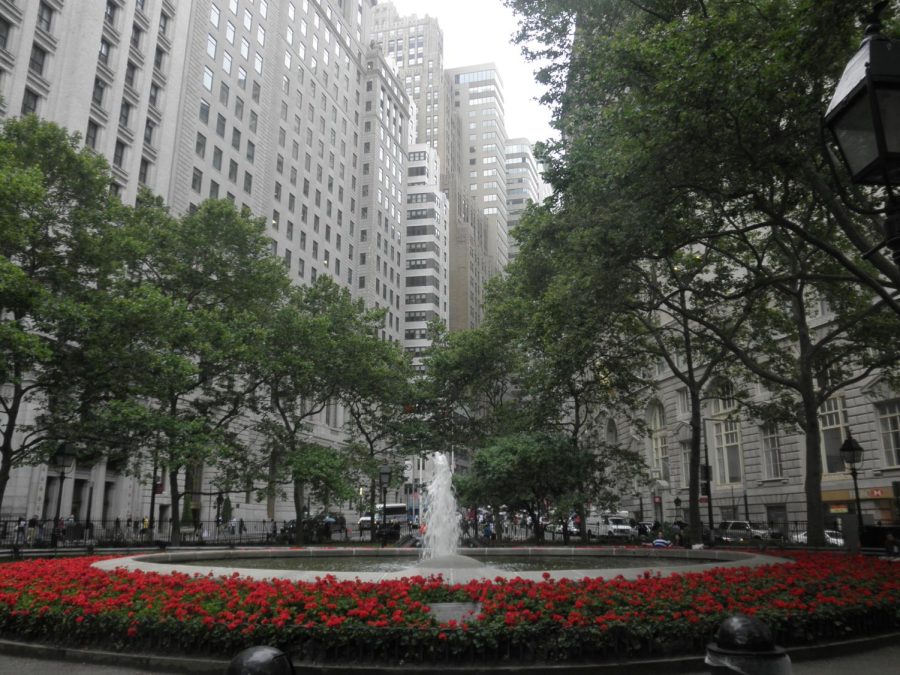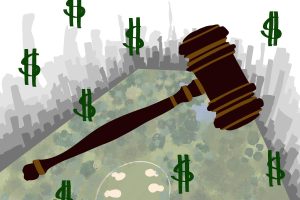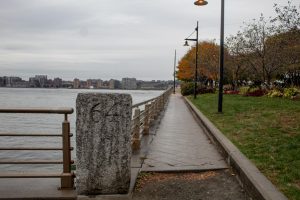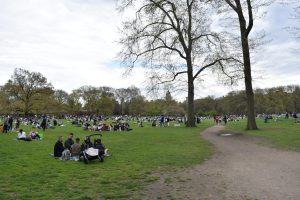New York City’s Green Spaces Date Back to 1733
The parks have experienced numerous fluctuations in funding due to changes in government administrations
GIGI ALT VIA WIKIMEDIA COMMONS
Bowling Green Park, located in the Financial District, was created in 1733 and was New York City’s first park.
October 26, 2022
New York is home to 180 state parks with locations spanning from Long Island to Niagara Falls in Buffalo. Belmont Lake State Park on Long Island and Niagara Falls State Park in Buffalo are two of the most popular state parks in New York. New York City alone houses more than 1,700 parks, playgrounds and recreational facilities across its boroughs, which take up 14% of the city in total. The landscape of these green spaces has a history dating back to 1686, when New York’s first park was designated in what is currently known as lower Manhattan’s Financial District.
The first parks in New York City were originally outdoor marketplaces and public commons acquired under the 1686 Dongan Charter of the City of New York, according to the New York City Department of Parks and Recreation. Thomas Dongan, New York’s first governor, granted the New York City Council, previously known as the Common Council, the power to utilize all “waste, vacant, unpatented and unappropriated lands” for municipal use.
Bowling Green Park, the first park in New York City, then solely defined as the borough of Manhattan, and was designated as a green space in 1733. Currently located in the Financial District, the Common Council leased the land for a small sum to John Chambers, Peter Bayard and Peter Jay in return for park maintenance.
After the British left New York in 1748, the assembly of the Congress of the Confederation made New York City the official capital of New York. The resulting influx of tourists incited improvements to city parks, especially The Battery, formerly known as Battery Park, which began deteriorating from overuse.
In 1811, however, former City Commissioners Gouverneur Morris, John Rutherfurd and Simeon De Witt noticed that the city’s rapid development left little room for the allocation of green spaces.
“It may be a matter of surprise that so few vacant spaces have been left … for the benefit of fresh air,” a group of commissioners shared during a development meeting about New York’s grid system, according to Phelps Stokes’ book “New York Past and Present: Its History and Landmark.”
A lack of land available for new parks generated a massive campaign for park reformation and development during the late 1840s and early 1850s. William Cullen Bryant — poet and namesake of Bryant Park, a park located in midtown Manhattan — argued for creating a central green space in New York City to alleviate the overcrowdedness from rising population rates. As a result, in 1852 the Common Council chose a site for Central Park and began its acquisition; subsequently, the Board of Commissioners of Central Park was created, with the first commissioners being former Mayor Fernando Wood and former Street Commissioner Joseph S. Taylor.
In 1857, landscape architects Frederick Law Olmsted and Calvert Vaux’s revolutionary design for Central Park, known as Greensward, won a nationwide contest. According to Robert Caro’s “The Power Broker,” Olmsted’s design included “half a million trees and shrubs on its 840 rocky, bared and arid acres, bowers, mazes, lawns and vistas, revolutionary sunken traverse roads, bridle paths, and delicate and colorful gardens.”
A little over a decade later in 1870, former U.S. Congressman William “Boss” Tweed and a group of politicians known as the Tweed Ring or Tammany Hall overthrew the Board of Commissioners of Central Park, established the Department of Public Parks in its place and appointed Peter B. Sweeny as commissioner. Sweeny subsequently fired Olmsted and Vaux.
In his book, Caro noted that Tammany Hall demolished many aspects of Olmsted and Vaux’s vision, such as cleaning up the “wilderness” along Fifth Avenue so park strollers would have a better view of the mansions.
In 1920, each borough was assigned its own commissioner to form the centralized New York City Department of Parks and Recreation.
In 1871, the Tweed ring was exposed for its corruption, and some of the previous commissioners were reinstated. Under this new administration, Central Park was completed, and parks such as Madison Square Park, Washington Square Park, Union Square Park and Tompkins Square Park were relandscaped. In 1872, the Department of Public Parks acquired the land that would eventually become Riverside Park.
The Department of Public Parks underwent another administrative change when Staten Island, Brooklyn and Queens were consolidated with Manhattan and the Bronx to become the “Greater New York” in 1898. At the time, the Bronx had 4,058 acres of public parks. Manhattan had about 1,300 acres, and Brooklyn and Queens had 1,574 acres combined Staten Island had less than three acres.
In 1920, each borough was assigned its own commissioner to form the centralized New York City Department of Parks and Recreation.
What worried New York City reformers the most was not the unsightly conditions of the parks but rather the lack of space available to create new parks.
The Great Depression had a detrimental impact on the physical conditions of New York City parks. Caro characterized New York City parks during this time as the “scabs on the face of the city.”
The Brooklyn Park Department was renting out park land for private uses. Playgrounds had essentially no equipment, and the remaining amenities were usually dangerous. Fences, benches and playground ironwork were rusted. Hermann W. Merkel, a landscape architect, formulated a report documenting the decline in park conditions and offered suggestions for maintenance.
What worried New York City reformers the most was not the unsightly conditions of the parks but rather the lack of space available to create new parks. The least amount of green space available was in the places that needed it, such as NYC tenements and lower-income areas.
“After nearly a century of agitation for the creation of ‘breathing spaces’ in slums, there were on the Lower East Side — in an area a mile wide into which were crammed more than half a million people — exactly two small parks, neither of which contained a single piece of play equipment,” Caro noted.
In 1933, former U.S. President Franklin D. Roosevelt’s New Deal gave Moses the necessary federal funding for his projects. Most of this funding would later be allocated to the construction of highways instead of public parks.
In 1932, there were only four playgrounds on the Lower East Side, four in Harlem and 36 in all of Brooklyn. In the city, there were 119 playgrounds total, equivalent at the time to one for every 14,000 children.
Around this time, Robert Moses gained notoriety as Long Island state park commissioner. Moses’ parks in Long Island were becoming the archetype of park development in New York. At the New York Park Association’s Metropolitan Conference, Moses began his plans to transform New York City parks alongside the creation of a new system of parkways.
In 1933, former U.S. President Franklin D. Roosevelt’s New Deal gave Moses the necessary federal funding for his projects. Most of this funding would later be allocated to the construction of highways instead of public parks.
A year later, former Mayor Fiorello H. LaGuardia appointed Moses as the sole commissioner of the Department of Parks and Recreation for New York City. Under Moses, public park projects skyrocketed, and the green spaces in the city changed forever. During Moses’ time as commissioner, park acreage expanded from 14,000 to 34,673 to include hundreds of playgrounds, three zoos, 10 golf courses and 53 recreational buildings, to name a few.
In 1968, then-Mayor John Lindsay created the Parks, Recreation and Cultural Affairs Administration to support libraries, botanical gardens and performing arts groups, yet the parks department itself suffered extreme budget cuts and staff reductions.
Many of Moses’ projects were limited to certain areas and demographics. His works were often not accessible by public transit. Moses instructed Sidney M. Shapiro, chief engineer and general manager of the Long Island State Park Commission, to build bridges above his parkways low enough that buses would not be able to fit underneath. Thus, bus trips to his parks and beaches had to be made on local roads due to the congestion caused by traffic on the highways Moses built, which made commutes to the parks longer.
When Black civic groups began to protest, Roosevelt ordered an investigation. According to Caro, one of Moses’ aides confirmed that “Bob Moses is seeking to discourage large black parties from picnicking at Jones Beach attempting to divert them to some other of the state parks.”
After Moses retired as commissioner in 1960, New York City parks were still dealing with issues with park maintenance. In 1968, then-Mayor John Lindsay created the Parks, Recreation and Cultural Affairs Administration to support libraries, botanical gardens and performing arts groups, yet the parks department itself suffered extreme budget cuts and staff reductions.
In 1981, however, then-Mayor Edward Koch allocated $750 million to restore city parks, and the parks department began rebuilding its permanent workforce.
“As a result, parks in affluent neighborhoods look much nicer and are better equipped because it is private money supplementing these parks.” Bruce Berg, political science and urban studies professor
Over the next few decades, new green spaces, parks and programs continued developing. Even so, park funding inequities remain an issue for parks in lower-income areas.
According to Bruce Berg, a professor in both the political science and urban studies departments at Fordham, New York’s park budget is notoriously low per capita compared to the parks budget in other cities. Parks in affluent areas tend to secure more private funding, such as Central Park and Riverside Park, whereas parks in lower-income neighborhoods rely on the Department of Parks and Recreation’s city-funded budget.
“As a result, parks in affluent neighborhoods look much nicer and are better equipped because it is private money supplementing these parks,” he said.
Play Fair, a campaign for parks and open spaces co-founded by New Yorkers for Parks, the New York League of Conservation Voters, District Council 37 and New York City Parks workers’ union, has created the Five Point Plan for Park Equity, which they request the Mayor and City Council to adopt.
Berg also discussed some notable initiatives under former Mayor Michael Bloomberg’s administration, such as converting school playgrounds into public parks and the MillionTreesNYC program, an initiative to plant and care for one million trees in New York City. Due to the COVID-19 pandemic, however, the Department of Parks and Recreation faced the second largest budget cuts of all of the city’s agencies.
Recently, the Committee on Parks and Recreation has recognized inequities and held a hearing in April 2022 to discuss their recommendations moving forward. Additionally, during his campaign for New York City mayor, Eric Adams expressed his commitment to allocating 1% of the city’s budget to the Department of Parks and Recreation, compared to the 0.5% it is currently receiving now. Adams’ 2023 executive budget, however, cut the department’s budget by $20 million.
Play Fair, a campaign for parks and open spaces co-founded by New Yorkers for Parks, the New York League of Conservation Voters, District Council 37 and New York City Parks workers’ union, has created the Five Point Plan for Park Equity, which they request the Mayor and City Council to adopt. The plan five points include: dedicating one percent of the city’s budget to parks, building more parks, reducing the amount of time park projects take in New York to complete, empowering communities and creating a director of the public realm.














